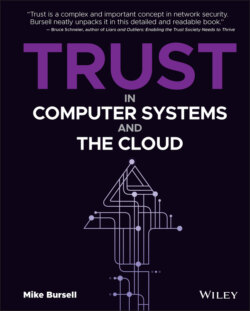Читать книгу Trust in Computer Systems and the Cloud - Mike Bursell - Страница 17
Defining Trust in Systems
ОглавлениеThe first problem with trusting systems is that the world of trust is not simple when we start talking about computers. We might expect that computers and computer systems, being less complex than humans, would be easier to consider with respect to trust, but we cannot simply apply the concept of trust the same way to interactions with computers as we do to interactions with humans. The second problem is that humans are good at inventing and using metaphors and applying a concept to different contexts to make some sense of them, even when the concept does not map perfectly to the new contexts. Trust is one of these contexts: we think we know what we mean when we talk about trust, but when we apply it to interactions with computer systems, it turns out that the concepts we think we understand do not map perfectly.
There is a growing corpus of research and writing around how humans build trust relationships to each other and to organisations, and this is beginning to be applied to how humans and organisations trust computer systems. What is missing is often a realisation that interactions between computer systems themselves—case four in our earlier examples—are frequently modelled in terms of trust relationships. But as these models lack the rigour and theoretical underpinnings to allow strong statements to be made about what is really going on, we are left without the ability to allow detailed discussion of risk and risk mitigation.
Why does this matter, though? The first answer is that when you are running a business, you need to know that all the pieces are correct and doing the correct thing in relationship to each other. This set of behaviours and relationships makes up a system, and the pieces its components, a subject to which we will return in Chapter 5: The Importance of Systems. We can think of this as similar to ensuring that your car is made up of the correct parts, placed in the correct locations. If you have the wrong brake cable, then you may find that when you press the relevant pedal, your brakes don't engage. In the same way, if you have multiple computer systems trying to talk to each other, and your database is not correctly integrated with the other components, you may find that when somebody places an order with your company, the order is not processed. When discussing these relationships and integrations in computing and IT, we sometimes talk about one component having a contract that it offers to other components. This contract will describe the expected behaviour of the component in terms of the inputs it receives and output that it provides. Providers of such components generally try to keep these contracts as firm and unchanging across versions as possible because any changes can significantly impact the behaviour of the rest of the system.
Think, for instance, of a component that is calculating the risk associated with an event. It takes as input a probability in a range from 0 to 1 and a dollar amount and then outputs the product of the two according to our formula. What would happen if a new version was released that, instead of taking the probability as a range from 0 to 1, expected a percentage (in the range from 0 to 100)? This would be a change to the contract, and any components integrated with this one—either for input or output—would need to be informed of the change and possibly updated in order for the system to work as expected.
To return to our definition:
“Trust is the assurance that one entity holds that another will perform particular actions according to a specific expectation”.
The contract is the “specific expectation” in this case. The contract is usually defined with an application programming interface (API), either expressed using one of a common set of descriptive languages or specific to the particular language in which the component is written. The first reason that being able to discuss risk management and mitigation is important, then, is to allow us to construct a business by integrating various systems along the lines of the contracts they provide. The second reason for its importance is security.
